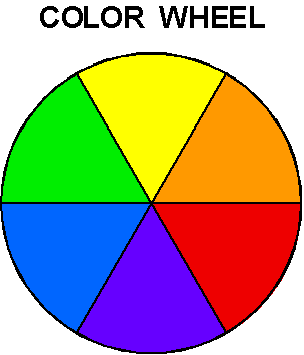Color theory
Color theory is an area of study pertaining to artistic color. It sets up groups of colors that are frequently used in art to create certain effects and harmony, and it is mostly based on the color wheel, a device originally invented by Sir Isaac Newton. Today the color wheel is usually presented as follows. According to the Interactive Design Foundation, "Color theory is the study of how colors work together and how they affect our emotions and perceptions. It's like a toolbox for artists, designers, and creators to help them choose the right colors for their projects. Color theory enables you to pick colors that go well together and convey the right mood or message in your work."[1]
Sir Isaac Newton, who invented the color wheel, was a theist. Color in nature does not clash. See: Argument from beauty
Contents
Color Triads
Primary colors are the three colors that cannot be derived from any other colors, yet can be mixed to form every color: red, blue, and yellow. They are spaced 120 degrees apart on the color wheel.
Secondary colors are the three colors that cam be created by mixing two primary colors: purple, green, and orange. They are spaced 120 degrees apart on the wheel.
Tertiary colors are colors the colors between the secondary and primary colors. There are six in all, categorized in to two sets of three, in each the colors equally spaced at 120 degrees. One set consists of red-orange, yellow-green, blue-purple, and the other consists of orange-yellow, green-blue, and red-purple.
Color Relationships
Complementary colors are colors that are opposite each other on the color wheel. They create an effect of contrast and harmony. An example is blue and orange.
Split complementary colors are three colors chosen in the following manner: the first color is chosen at random, and the other two are the colors on either side of its complement. An example is red, blue-green, and yellow green.
Analogous colors are four or five colors adjacent to each other on the color wheel.
A triad is a group of three colors spaced 120 degrees apart, such as green, purple, and orange.
Chromatic gray is gray, created not by mixing black and white but by mixing two complements (i.e. red and green.) It appears to be a less dull gray than the one created by mixing black and white.
Color Groups
Pastel colors refer to the colors of the color wheel mixed with white. They usually are of medium intensity.
Jewel colors refer to the colors of the color wheel mixed with black. They usually are of high intensity.
Earth colors refer to the colors of the color wheel mixed with brown. They usually are of low intensity
See also
External links
- Color Theory, Interaction Design Foundation
References
- ↑ Color Theory (CT), Interactive Design Foundation
